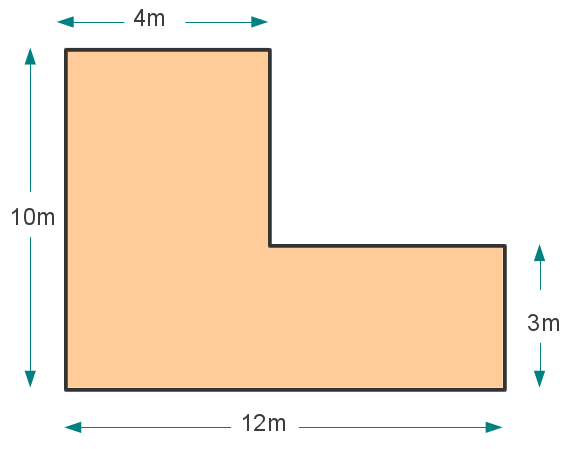
[ home ]

Like many further education colleges and adult education centres we give all students who want to take a GCSE course a short initial Maths test. A question near the end of the test asks for the perimeter and then the area of a composite shape like the one shown above. Remarkably few prospective students can manage that question. As I have access to hundreds of scripts, I'll be doing some simple stats on the variety of errors in a future page.
Because of the response to that question, I do about half a lesson on perimeter and area in the first few weeks of the course. I like to link these ideas to factors and symbols so that the material will help with some of the puzzle questions in the AQA Unit 2 maths exam.
We start off with length by measuring and area by counting squares. I used a Google Maps outline of a local lake printed onto squared paper for the counting squares: the linear scale was about 50m to 1cm so a 'stretch' outcome was working out the area of the actual lake in square metres.The square counts ranged between 80 and 85 square centimetres which is reasonable given the curves in the banks of the lake.
Then I asked students to draw a rectange with an area of 12 square centimetres on 1cm squared paper (papersnake has a pdf file of a 1cm square grid). A reasonable variety of rectanges emerged, 12 by 1, 3 by 4 and 6 by 2. I linked those to the factors of 12.
Next I suggested drawing a rectangle with a perimeter of 24cm after drawing a few small rectangles on the whiteboard. The three formulas came out of whole class questioning;
and I pointed out that understanding how those three formulas are the same covers a fair chunk of the AQA Unit 2 algebra content. We looked at how to work backwards: take half the 24 then just think up a couple of numbers that add to 12. The last formula is the most useful for working backwards like that.
Then came the challenge question: a rectangle has an area of 24cm2 and a perimeter of 22cm. Draw it on the squared paper. Quite a bit of coaching was needed for some students, others realised that the best strategy is to list the factors of 24 first then check by adding which combination adds to 11.
A follow up question: area is 32cm2 and perimeter is 24cm. I followed this up with some easier questions and a few composite shapes.
I'm trying to make as many links as I can between abstract things like factors and more concrete contexts such as the area and perimeter of rectangles. The new style exam questions are quite keen on these sort of links.
Keith Burnett, Last update: Sun Oct 07 2012